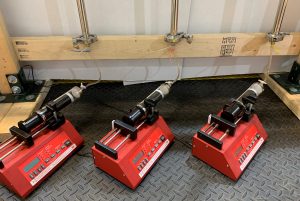 XDD Environmental can test several technologies simultaneously to determine which remedial option will best meet our client’s goals.
XDD Environmental can test several technologies simultaneously to determine which remedial option will best meet our client’s goals.
Comparative treatabilitiy studies will identify the strengths and weaknesses of each technology under site conditions to increase the reliability of the decision-making processes. These studies include evaluation of known approaches to a site pollutant (such as increasing pH in the case of metal migration), to evaluating existing products (such precipitation products for metal migration).
XDD’s experience in treatability lab testing includes:
- Metal stabilization
- In situ chemical reduction
- Surfactant-enhanced treatment
- Oxygen-releasing products
- Nutrient or biostimulation products
In addition, XDD incorporates our own field implementation experience into the design to increase the usefulness of the results. Design and dosing considerations are compared to field feasibility to ensure the most useful information is gathered to aid in decisions and design of field implementation.
Email XDD at lcrawford@xdd-llc.com with inquiries about our treatability testing services. Additionally, a selection of our case studies can be found here.
Treatability Studies
XDD performs treatability testing and microcosm studies to evaluate the site specific feasibility and to develop field-scale design parameters for all common in situ remediation technologies:
- In Situ Chemical Oxidation:
- Catalyzed Hydrogen Peroxide
- Activated Persulfate
- Permanganate
- In Situ Chemical Reduction:
- Zero Valent Iron (ZVI)
- Bi-Metallic Particles
- Metal Sulfides
- In Situ Bioremediation
- Aerobic
- Anaerobic
- Biostimulation
- Bioaugmentation
- In Situ Metals Stabilization
- pH adjustment
- metals sorption
- metals precipitation
- metals co-precipitation
Specialty Services
XDD Environmental will customize our treatability services to meet you site-specific needs. Our most recent approaches include:
- Thermal enhanced soil vapor extraction
- Thermally enhanced bioremediation
In-House Analytical Capabilities
- Natural attenuation parameters
- Dissolved gases such as methane, ethene, and ethane by gas chromatography (GC)
- Volatile chlorinated compounds by GC
- Alcohols, glycols, and water soluble ethers by GC
- Organic acids such as formate, lactate, and acetate by capillary ion electrophoresis and by ion chromatography
- Molecular hydrogen by reduction gas analysis
- Anions such as nitrate, nitrite, phosphate, chloride and sulfate

